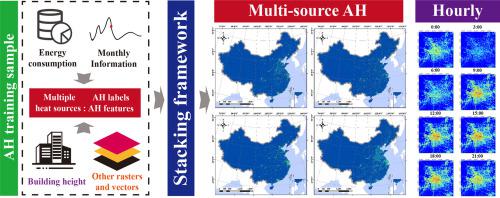Resources, Conservation and Recycling ( IF 11.2 ) Pub Date : 2024-01-20 , DOI: 10.1016/j.resconrec.2024.107451 Jiangkang Qian , Linlin Zhang , Uwe Schlink , Qingyan Meng , Xue Liu , Tamás Janscó

|
Anthropogenic heat (AH) emissions have rapidly increased in recent decades and are now critical for studying urban thermal environments; however, AH datasets composed of multiple heat sources with fine and accurate spatiotemporal characteristics at large scales are lacking. This study obtained annual, monthly, and hourly AH of multiple heat sources in China for 2019 at 500 m resolution. We first corrected the top-down inventory method for China, which is based on official energy consumption data. Then, we considered features such as the national building height, weighted factory density, and weighted road density to better represent the spatial characteristics of multi-source AH. Based on the above data preparation, a stacking framework was employed to integrate multiple machine-learning algorithms to construct an efficient and accurate AH estimation model. Finally, besides the comparative validation, the results were further tested by participating in a short-term climate numerical simulation for both winter and summer. The resulting data showed a reasonable AH composition and the total amount and composition of AH varied notably from region to region. The spatial and temporal characteristics of the AH from different sources differed greatly and were more detailed and accurate than those reported in previous studies. Air temperature simulations in winter were improved by the AH dataset input, but the uncertainties of climate simulations also limit its validity in AH validation. Because of its large spatial extent and detailed spatiotemporal characteristics, the new dataset strongly supports urban climate research and sustainable development.






























 京公网安备 11010802027423号
京公网安备 11010802027423号